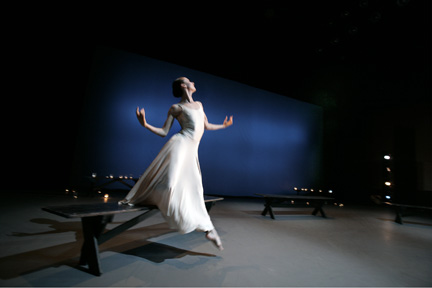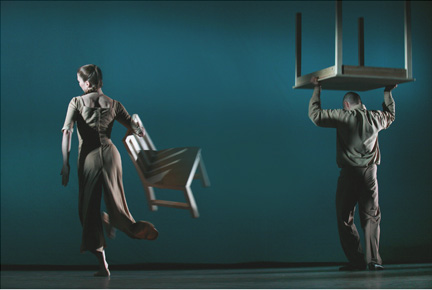Divas in Undefined Space
“Witness,”“Les Bras de Mers,”“Ghosts”
Royal Danish Ballet
Takkelloftet
Copenhagen, Denmark
April 20, 2007
by Eva Kistrup
copyright © 2007 by Eva Kistrup
 When Alvin Ailey choreographed the otherwise unmemorable “Caverna Magica” for the Royal Danish Ballet, he felt inspired to create an additional solo piece for Copenhagen ballerina Mette Hønningen, called “Witness”, a gospel piece in the style of “Cry”. Ailey was fascinated by the beautiful Danish ballerina, groomed for the classic parts by Vera Volkova and with a strong gift for modern ballet as well — a gift that was used by guest modern choreographers like Ailey, Glen Tetley and Choo San Goh, who all choreographed for the then-mature ballerina. Since retirement Mette Hønningen has not often been used as a coach by the company, which is a great loss because as the last ballerina totally developed by Vera Volkova and a strong dramatic artist in her own right, she could have been a valuable continuing inspiration and guide for the next generations. For an American audience she is probably best known from the Disney film “The Ballerina”.
When Alvin Ailey choreographed the otherwise unmemorable “Caverna Magica” for the Royal Danish Ballet, he felt inspired to create an additional solo piece for Copenhagen ballerina Mette Hønningen, called “Witness”, a gospel piece in the style of “Cry”. Ailey was fascinated by the beautiful Danish ballerina, groomed for the classic parts by Vera Volkova and with a strong gift for modern ballet as well — a gift that was used by guest modern choreographers like Ailey, Glen Tetley and Choo San Goh, who all choreographed for the then-mature ballerina. Since retirement Mette Hønningen has not often been used as a coach by the company, which is a great loss because as the last ballerina totally developed by Vera Volkova and a strong dramatic artist in her own right, she could have been a valuable continuing inspiration and guide for the next generations. For an American audience she is probably best known from the Disney film “The Ballerina”.
Luckily this time the legend is back (last time “Witness” was produced the theatre did not bother to call Hønningen, who only was brought in after press intervention), and she has taught her legacy to three dancers: Principal Dancer, Marie Pierre Greve; recently appointed principal Amy Watson; and Spanish member of the company, Alba Nadal.
Marie Pierre Greve, who danced the premiere, is a fine classical and expressive dancer, but not a natural modern dancer, and her interpretation was a little too much a copy of Hønningen rather than an original take. Neither could she keep the tension in the piece, but in all it was a present revival of one of the few pieces created for the Royal Danish Ballet of lasting value.
 What was not okay was the fact that the programme was performed at the small second stage at the new opera, Takkelloftet, which is simply not suited for dance performances. Dancing needs defined space and Takkelloftet, designed for total flexibility, can provide everything but a room for dancing. Performances take place at floor level, there is no proscenium so there is no defined space. The audience is placed at a wrong angle. And there is no reason that this room should be used for dance performance as the “New” stage at Kongens Nytorv has been beautifully restored and is a perfect space for smaller performances.
What was not okay was the fact that the programme was performed at the small second stage at the new opera, Takkelloftet, which is simply not suited for dance performances. Dancing needs defined space and Takkelloftet, designed for total flexibility, can provide everything but a room for dancing. Performances take place at floor level, there is no proscenium so there is no defined space. The audience is placed at a wrong angle. And there is no reason that this room should be used for dance performance as the “New” stage at Kongens Nytorv has been beautifully restored and is a perfect space for smaller performances.
Kim Brandstrup had his own recipe for dealing with the unsuitable room. His work “Ghosts” simply included a screen in front of the dancers, thereby defining the room and leaving the abstract piece with a dreamy atmosphere and coordinates that very effectively squires the dancers. Given the fact that Brandstrup is one of the only Danish choreographers with an international resume of dramatic ballet, it is surprising that this is only his third work for the Royal Danish Ballet. This time around he has chosen 18th century music like Vivaldi for five pieces, with a central Pas de Deux for Gudrun Bojesen and Thomas Lund. This is the third 18th century outing for this pair this season following their Mozart Pas de deux and “Carolie Mathilde”. It could sem like to much of a good thing but 18th century themes are what Bojesen and Lund does best, considering their musicality and style, so it is a joy to watch the perfect combination of Brandstrups' original legato step sequences and strong stage personalities at work. Around Bojesen and Lund, Silja Schandorff dances a sort of goddess part (she blows lifes into Bojesen's doll like figure, so a goddess she may be) and the two very good young men Ulrik Birkjær (the recent winner of The Erik Bruhn Prize) and Alexander Stæger form the rest of the cast. The title “Ghosts” is inspired by Bournonville's remarks about his Paris teachers who continued to be an influence in his work. With “Ghosts” we get an intelligent, well choreographed piece for a group of our best dancers, whih is not something we get on a daily basis.
 Sandwiched between the two original works was “Les Bras de Mer” a pas de quatre for a man, a woman, chair and table by Petr Zuska, a piece presented last seoson. Silja Schandorff came down from the Olympics to dance the part of a worn-out housewife with kneepads in a dance with a macho Jean Luc Massot, well danced with a lot of nerve, but do really care for dancing furniture when the real thing is around?
Sandwiched between the two original works was “Les Bras de Mer” a pas de quatre for a man, a woman, chair and table by Petr Zuska, a piece presented last seoson. Silja Schandorff came down from the Olympics to dance the part of a worn-out housewife with kneepads in a dance with a macho Jean Luc Massot, well danced with a lot of nerve, but do really care for dancing furniture when the real thing is around?
Photos (all by Per Martin Abrahmsen), from top:
Marie Pierre Greve in "Witness."
Gudrun Bojesen and Thomas Lund in "Ghosts."
Silja Schandorff and Jean Luc Massot in "Les Bras de Mer."
Volume 5, No. 17
April 30, 2007
copyright ©2007 by Eva Kistrup
www.danceviewtimes.com